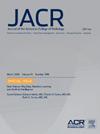直肠癌远处转移的影像学评价差异。
IF 5.1
3区 医学
Q1 RADIOLOGY, NUCLEAR MEDICINE & MEDICAL IMAGING
引用次数: 0
摘要
目的:探讨直肠癌患者首次接受远处转移影像学检查的人口学因素以及诊断和影像学检查之间的时间差。方法:回顾性回顾来自癌症登记处的连续直肠腺癌患者是否存在远处转移成像,以及接受的成像是否符合NCCN和ESMO指南所确定的一线模式。我们获得了种族、性别、年龄、体重指数、人口普查区域和保险支付者的临床人口统计分类数据。所做的分析包括描述性分析和逻辑回归分析。结果:329例患者中,男性占61.4%,平均年龄58岁。从组织诊断到成像系统分期完成的平均时间间隔为20.6天。在多变量分析中,非西班牙裔患者OR 4.57 (CI 2.27, 9.19)、超重患者OR 4.55 (CI 2.04, 10.12)和肥胖患者OR 4.21 (CI 1.70, 10.45)完成初始分期的可能性更大,而在单变量分析中,公共保险患者(P = 0.03)接受分期的可能性更小。多变量分析中,诊断年份较近的患者OR为1.26 (CI 1.07, 1.50),单变量分析中,年龄较轻(P = 0.04)和居住城市(P < 0.01)的患者与一线影像学相关。BMI较低的患者与影像学及时性的提高相关(P = .03)。结论:多种人口统计学因素影响影像学的完成、推荐影像学的接受以及接受影像学的时间间隔。因此,有必要确保充分遵守最初的检查建议,并改善放射治疗途径。本文章由计算机程序翻译,如有差异,请以英文原文为准。
Disparities of Distant Metastasis Evaluation Imaging for Rectal Cancer
Purpose
The aim of this study was to determine demographic factors associated with receipt of initial distant metastasis imaging and the time delay between diagnosis and imaging among patients with rectal cancer.
Methods
Consecutive patients with rectal adenocarcinoma from a cancer registry were retrospectively reviewed for the presence of distant metastasis imaging and whether the received imaging was the first-line modality as determined by National Comprehensive Cancer Network and European Society for Medical Oncology guidelines. We obtained data for the clinical-demographic categories of ethnicity, sex, age, body mass index, census block, and insurance payer. Analyses included descriptive analysis and logistic regression analysis.
Results
Of 329 patients, 61.4% were male, and the average age was 58 years. The average time interval from tissue diagnosis to imaging systemic staging completion was 20.6 days. In multivariable analysis, non-Hispanic patients (odds ratio [OR], 4.57; 95% confidence interval [CI], 2.27-9.19) and those who were overweight (OR, 4.55; 95% CI, 2.04-10.12) and obese (OR, 4.21; 95% CI, 1.70-10.45) were more likely to complete initial staging, with those with public insurance (P = .03) less likely to receive staging in univariable analysis. Patients with more recent year of diagnosis (OR, 1.26; 95% CI, 1.07-1.50) in multivariable analysis and those with younger age (P = .04) and urban residence (P < .01) in univariable analysis were associated with first-line imaging modality. Low body mass index was correlated with improved imaging timeliness (P = .03).
Conclusions
Multiple demographic factors affect the completion of imaging, receipt of recommended imaging, and the time interval to receive imaging. It is therefore necessary to ensure adequate compliance with initial workup recommendations and to improve radiologic access.
求助全文
通过发布文献求助,成功后即可免费获取论文全文。
去求助
来源期刊

Journal of the American College of Radiology
RADIOLOGY, NUCLEAR MEDICINE & MEDICAL IMAGING-
CiteScore
6.30
自引率
8.90%
发文量
312
审稿时长
34 days
期刊介绍:
The official journal of the American College of Radiology, JACR informs its readers of timely, pertinent, and important topics affecting the practice of diagnostic radiologists, interventional radiologists, medical physicists, and radiation oncologists. In so doing, JACR improves their practices and helps optimize their role in the health care system. By providing a forum for informative, well-written articles on health policy, clinical practice, practice management, data science, and education, JACR engages readers in a dialogue that ultimately benefits patient care.
 求助内容:
求助内容: 应助结果提醒方式:
应助结果提醒方式:


